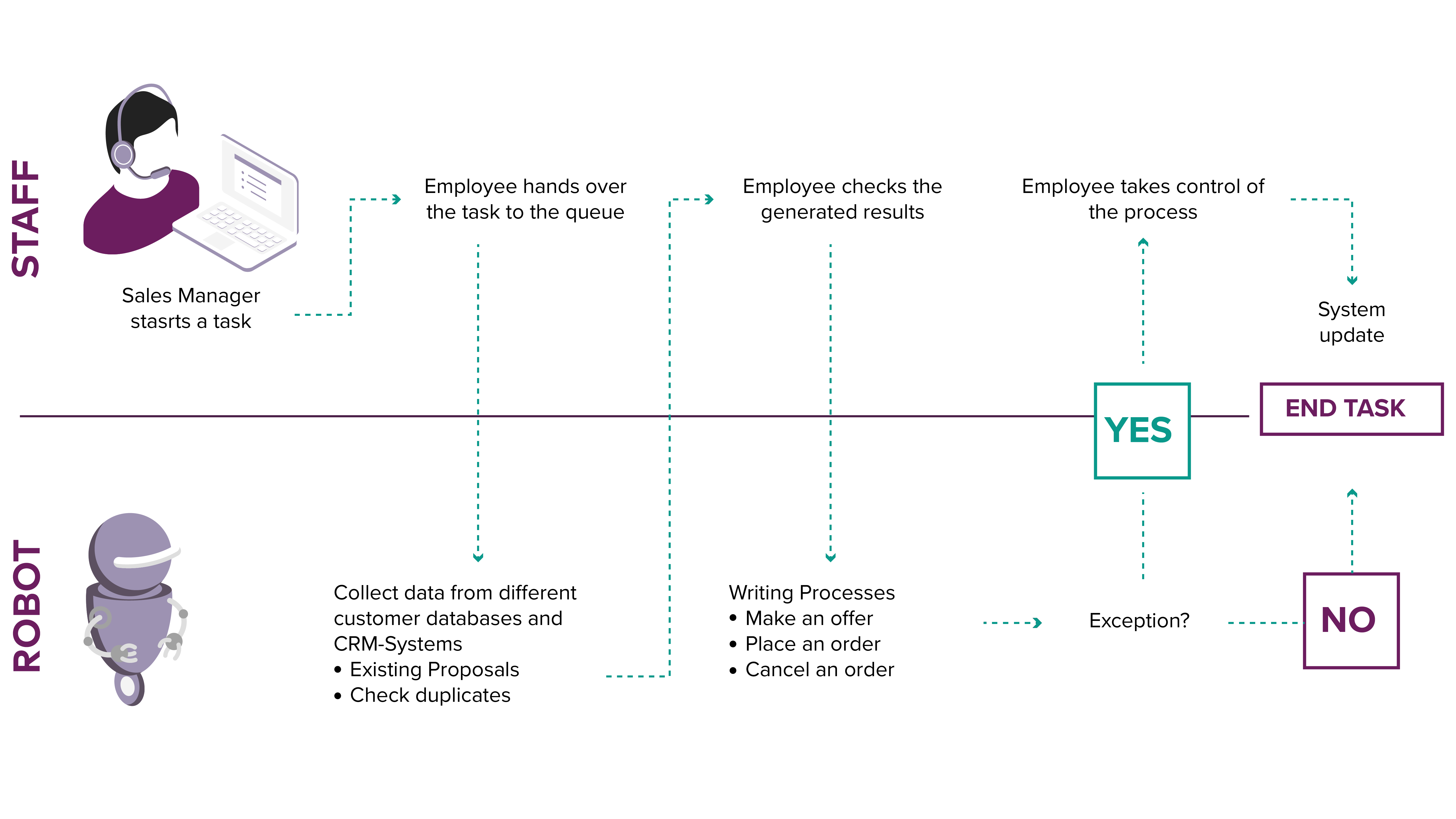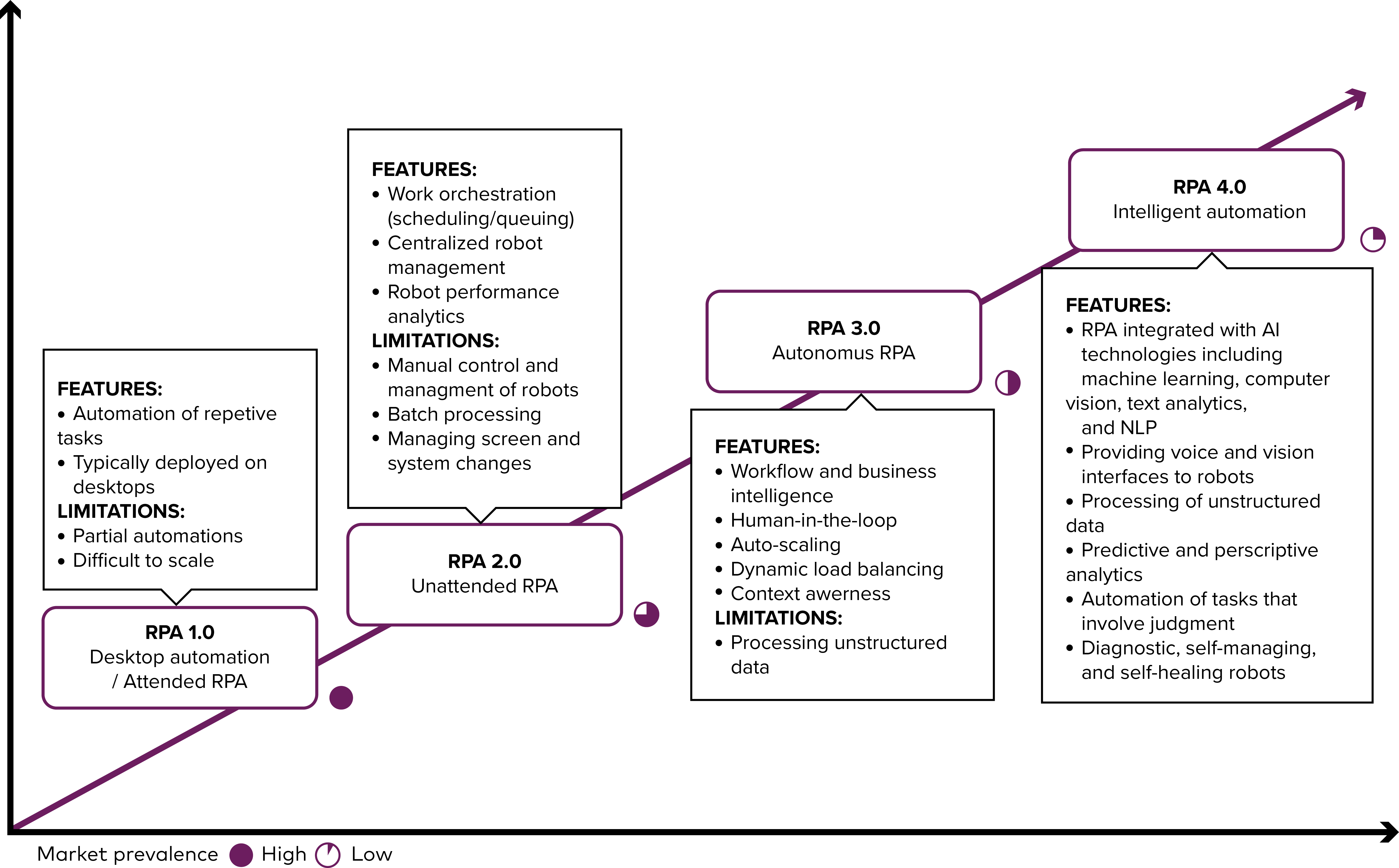With the rapid growth of technology, companies can utilize more and more advanced solutions for business automatization. The main benefits include cost reduction, more effective customer relationships, and freeing up employees from repetitive and tedious tasks.
Thanks to evolving business automation, solutions can perform more significant and more advanced tasks. The development of automation and artificial intelligence enables creating more complex solutions that no longer require human interference.
Having that in mind, market leaders are now focusing not only on processes that offer partial automation but also on developing fully automated AI-based solutions. Because in the latter case, the user does not act as the initiator of the process but only supports it when necessary.
Robotic Process Automation (RPA) 2.0 responds to those needs. But what is the actual benefit that it can bring to your company?
What Is Robotic Process Automation 2.0?
Robotic Process Automation, in its concept, allows automating various repetitive, rule-based processes that are traditionally performed by users. From simple tasks to automating data entry, RPA may be responsible for different business roles. Most commonly, suited processes are back-office tasks like financial planning and analysis, billing, order processing, accounting reconciliation, or ERP data entry.


This automation is rapidly growing. Gartner estimated that, by 2021, 90% of large and midsize companies will have processes supported by RPA.
Moreover, this technology costs only one-third of an offshore employee and just one-fifth of an onshore employee. Deloitte studies prove that more than 90% of already implemented RPA solutions have met or exceeded the expected productivity and compliance incensement.
Attended vs. Unattended RPA
Automation empowered by RPA can be performed on a workstation level, where a robot is replicating manual process steps – a task that usually a user does. But in this case, the user only needs to start it, and the robot will do all planned steps.
The robot will go through all necessary applications, look for specifically required information on the screen, combine them to get the expected result, trigger transaction processes, or store the data in a dedicated location. The control will be handed back to the user should certain conditions occur – mainly if a human decision should be needed.
This approach is called Attended RPA or RPA 1.0. It’s a more basic automation type where the user’s attention is required, and the robots act like a human would, by replicating all steps in compliance with business logic.


A different approach to RPA is called unattended RPA or RPA 2.0. In RPA 2.0, a server-side robot runs the entire process. There is no need for a human to log into the machine to trigger the process, and usually, the results and flow can be managed with a dedicated dashboard. With such a tool, the human operator can manage parameters, check performance, adjust priorities, and intervene when needed.
The AI development enabled the first attempts to create robots that could potentially use the machine learning technics to learn how the process flows and recreate its steps. This allows us to avoid respective programming processes manually; instead, the robot spends a few days (or hours) observing human work to reproduce it later.
This type of automation is still in its early stages, but the potential is undoubtedly massive.


What Is The Benefit?
There are many advantages to implementing automation. In the case of RPA 2.0, we use all the possibilities from the “unattended” robot work.
The following are key benefits that implementation of RPA 2.0 in an organization can bring.


- 24/7 accurate processing
Thanks to RPA 2.0, robots located on servers no longer require human initiation to process virtually 24/7 without interruptions.
This way, we are no longer limited by standard human work times. Thanks to such a solution, we can quickly improve customer satisfaction. The customer could use the offered service at any time – whether he needs anything in standard working hours or outside of them, he would receive an answer immediately.
Also, this work is not burdened with the risk of high loads or after-hours work, thanks to which the results can often be more accurate.
- Scalability
The implementation of RPA 2.0 enables better scalability thanks to high flexibility in processing more queries and adapting to changes.
This eliminates the problem of overwork or, especially for some businesses, seasonality, where specific periods are loaded several times higher than others. It’s also the right solution when processes change – the responsible person can focus on procedures and modifying robots, not on remembering and using them.
- Administration, monitoring and analytics possibilities
Another advantage is the ease in managing business processes.
Employees often monitor robots. Statistics collected during their work can be processed and used to understand the process better and improve it. Also, thanks to RPA, we can ensure the suitability of methods and their full monitoring. All these aspects allow better tracking, understanding, and faster process improvement, which certainly increases customer satisfaction.
- Cost reduction and accuracy
The implementation of automation allows us to eliminate tedious and repetitive tasks and, above all, to process them faster.
All this leads to a reduction in the cost of maintaining processes. Also, errors are much less likely due to clearly defined automation steps. Robots work following a clearly defined path, eliminating the risk of human error, which is not tricky at low-engaging repetitive activities.
- Increasing customer satisfaction
With automation, we can expect better and quicker results.
The ability to provide more accurate and faster process results can significantly affect customer perception. Additionally, in the era of hue IT competition, the increased quality and lower waiting times is another clear advantage.
- Improved work quality
RPA can have a positive impact on the processes not only from the customer’s perspective but also for the employee.
Thanks to automation, they can focus on more critical issues such as responding to regulatory changes, modifications and streamlining the process or handling individual cases.
What’s The Future Of RPA?
The Robotic Process Automation is still developing, but we can already see where the chances for its further development are.
Thanks to AI, robots will become more and more independent of human work. The next stage is autonomous robots – RPA 3.0 – and cognitive robots (RPA 4.0), where robots will take full advantage of AI opportunities.


Source:
Deloitte RPA Brochure – March 2019
Deloitte Report: Automation with Intelligence
Attended Automation: What Is It and Why Do I Need It?
Attended vs. Unattended RPA Robots: What You Need
Intelligent Digital Robots or RPA 2.0





